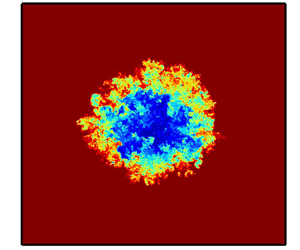Published online by Cambridge University Press: 23 August 2022

A quasi-dynamic subgrid-scale (SGS) kinetic energy one-equation eddy-viscosity model is introduced in this paper for large-eddy simulation (LES) of compressible flows. With the additional SGS kinetic energy equation, the SGS kinetic energy can be predicted properly. Then, using the dual constraints of SGS kinetic energy and the SGS kinetic energy flux, the eddy-viscosity model can be determined exactly. Taking a similar scheme as the expansion of the SGS stress, other unclosed quantities in the equations to be solved could be well modelled separately. Therefore, with the advance of the equations, all the model coefficients can be determined dynamically. Differing from the classic dynamic procedure, the new methodology needs no test filtering, and thus it could also be called a quasi-dynamic procedure. Using direct numerical simulation of compressible turbulent channel flow, the  $a$
$a$  $priori$ test shows that the key modelled quantities of the suggested model display high correlations with the real values. In LES of compressible turbulent channel flows of the Mach number being
$priori$ test shows that the key modelled quantities of the suggested model display high correlations with the real values. In LES of compressible turbulent channel flows of the Mach number being  $1.5$ and 3.0, the proposed model can precisely predict some important quantities, including the mean velocity, Reynolds stress and turbulent flux, and it can also supply more abundant turbulent structures. For the compressible flat-plate boundary layer, the new model can correctly predict the transition process, mean velocity and turbulence intensities in the turbulent region. The results show that the proposed model has the advantage of scale adaptivity. Finally, the new model is applied to LES of turbulent mixing in spherical converging Richtmyer–Meshkov instability, and the accurate results show that the new model has a good ability for LES of complex fluids.
$1.5$ and 3.0, the proposed model can precisely predict some important quantities, including the mean velocity, Reynolds stress and turbulent flux, and it can also supply more abundant turbulent structures. For the compressible flat-plate boundary layer, the new model can correctly predict the transition process, mean velocity and turbulence intensities in the turbulent region. The results show that the proposed model has the advantage of scale adaptivity. Finally, the new model is applied to LES of turbulent mixing in spherical converging Richtmyer–Meshkov instability, and the accurate results show that the new model has a good ability for LES of complex fluids.